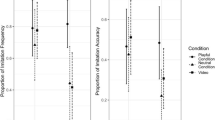Abstract
Behavior development in normal children is greatly facilitated by peer modeling. Unfortunately, autistic children do not typically imitate their normal peers. The present study was undertaken to identify variables that facilitate the acquisition of peer imitation and promote setting generality of imitative skills once they have been acquired. We selected a common preschool activity (Follow-the-Leader) as the vehicle for studying modeling effects. Four preschool children with autism took part in an intervention in which a normal peer demonstrated and, if necessary, physically prompted a variety of actions and object manipulations that defined the activity. Following training, all four children generalized their imitative skill to a new setting involving new actions and object manipulations. Results are discussed with respect to the potentially important role that the use of multiple training objects and/or responses play in enhancing attention to the model and facilitating setting generality as well as the role that intrinsically reinforcing activities may play in maintaining acquired peer imitation.
Similar content being viewed by others
References
Blew, P. A., Schwartz, I. S., & Luce, S. C. (1985). Teaching functional community skills to autistic children using nonhandicapped peer tutors.Journal of Applied Behavior Analysis, 18, 337–342.
Canale, J. R. (1977). The effect of modeling and length of ownership on sharing behavior of children.Social Behavior and Personality, 5, 187–191.
Carr, E. G., & Kologinsky, E. (1983). Acquisition of sign language by autistic children: II. Spontaneity and generalization effects.Journal of Applied Behavior Analysis, 16, 297–314.
Charlop, M. H., Schreibman, L., & Tryon, A. S. (1983). Learning through observation: The effects of peer modeling on acquisition and generalization in autistic children.Journal of Abnormal Child Psychology, 11, 355–366.
Charlop, M. H., & Walsh, M. E. (1986). Increasing autistic children's spontaneous verbalizations of affection: An assessment of time delay and peer modeling procedures.Journal of Applied Behavior Analysis, 19, 307–314.
Coleman, S. L., & Stedman, J. M. (1974). Use of a peer model in language training in an echolalic child.Journal of Behavior Therapy and Experimental Psychiatry, 5, 275–279.
Egel, A. L., Richman, G. S., & Koegel, R. L. (1981). Normal peer models and autistic children's learning.Journal of Applied Behavior Analysis, 14, 3–12.
Geshuri, Y. (1972). Observational learning: Effects of observed reward and response patterns.Journal of Educational Psychology, 63, 374–380.
Grusec, J. E., & Abramovitch, R. (1982). Imitation of peers and adults in a natural setting: A functional analysis.Child Development, 53, 636–642.
Ihrig, K., & Wolchik, S. A. (1988). Peer versus adult models in autistic children's learning: Acquisition, generalization, and maintenance.Journal of Autism and Developmental Disorders, 18, 61–19.
Kazdin, A. E., (1973). The effect of vicarious reinforcement on attentive behavior in the classroom.Journal of Applied Behavior Analysis, 6, 71–78.
Lancioni, G. E. (1982). Normal children as tutors to teach social responses to withdrawn mentally retarded schoolmates: Training, maintenance, and generalization.Journal of Applied Behavior Analysis, 15, 17–40.
Lovaas, O. I. (1981).Teaching developmentally disabled children. Baltimore: University Park Press.
Lovaas, O. I., Berberich, J. P., Perloff, B. F., & Schaeffer, B. (1966). Acquisition of imitative speech by schizophrenic children.Science, 151, 705–707.
Lovaas, O. I., Freitas, L., Nelson, K., & Whalen, C. (1967). The establishment of imitation and its use for the development of complex behavior in schizophrenic children.Behaviour Research and Therapy, 5, 171–181.
McCall, R. B., Parke, R. D., & Kavanaugh, R. D. (1977). Imitation of live and televised models by children one to three years of age.Monographs of the Society for Research in Child Development, 42 (5, Serial No. 173).
Stokes, T. F., & Baer, D. M. (1977). An implicit technology of generalization.Journal of Applied Behavior Analysis, 10, 349–367.
Strain, P. S., Kerr, M. M., & Ragland, E. U. (1979). Effects of peer mediated social initiation and prompting/reinforcement procedures on the social behavior of autistic children.Journal of Autism and Developmental Disorders, 9, 41–54.
Varni, J. W., Lovaas, O. I., Koegel, R. L., & Everrett, N. L. (1979). An analysis of observational learning in autistic and normal children.Journal of Abnormal Child Psychology, 7, 31–43.
Wahler, R. G. (1969). Setting generality: Some specific and general effects of child behavior therapy.Journal of Applied Behavior Analysis, 2, 239–246.
Wolf, T. M. (1973). Effects of live modeled sex-inappropriate play in a naturalistic setting.Developmental Psychology, 9, 120–123.
Author information
Authors and Affiliations
Additional information
This investigation was supported in part by U.S. Public Health Service Biomedical Research Support grant 2 S07 RR-07067-18 to the State University of New York at Stony Brook. We thank Martin Hamburg, Executive Director, Suffolk Child Development Center, for his generous support.
Rights and permissions
About this article
Cite this article
Carr, E.G., Darcy, M. Setting generality of peer modeling in children with autism. J Autism Dev Disord 20, 45–59 (1990). https://doi.org/10.1007/BF02206856
Issue Date:
DOI: https://doi.org/10.1007/BF02206856




